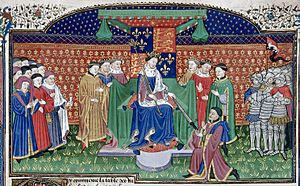Henry VI of England facts for kids
Quick facts for kids Henry VI |
|
|---|---|
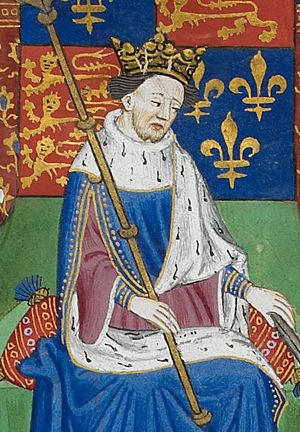
Miniature of Henry VI in the Talbot Shrewsbury Book, 1444–1445
|
|
| King of England (more...) | |
| Reigns |
|
| Coronation | 6 November 1429, Westminster Abbey |
| Predecessor | Henry V |
| Successor | Edward IV |
| Regents |
See list
|
| King of France (disputed) | |
| Reign | 21 October 1422 – 19 October 1453 |
| Coronation | 16 December 1431, Notre-Dame de Paris |
| Predecessor | Charles VI |
| Successor | Charles VII |
| Regent |
|
| Born | 6 December 1421 Windsor Castle, Berkshire, England |
| Died | 21 May 1471 (aged 49) Tower of London, London, England |
| Burial | 12 August 1484 St George's Chapel, Windsor Castle, England |
| Spouse | |
| Issue | Edward of Westminster, Prince of Wales |
| House | Lancaster (Plantagenet) |
| Father | Henry V of England |
| Mother | Catherine of Valois |
| Signature |  |
Henry VI (born 6 December 1421, died 21 May 1471) was the King of England from 1422 to 1461. He ruled again from 1470 to 1471. He was also the disputed King of France from 1422 to 1453.
Henry was the only child of King Henry V. He became King of England when he was just nine months old, after his father died. Soon after, he also became King of France when his grandfather, Charles VI, passed away.
Henry inherited the long Hundred Years' War (1337–1453). In this war, his uncle Charles VII fought against Henry's claim to the French throne. Henry is the only English king to have been crowned King of France, which happened in 1431.
When he was very young, other people ruled for him. During this time, England had a lot of power in France. But later, problems with the army, diplomacy, and money weakened England's position. By 1437, when Henry was old enough to rule, his kingdom was in trouble. He faced losses in France and disagreements among his nobles at home.
Unlike his father, Henry was described as quiet, shy, and not interested in war. He was also sometimes mentally unwell. During his time as king, England slowly lost its lands in France. In 1445, Henry married Margaret of Anjou, hoping for peace. She was a strong-willed niece of Charles VII.
The peace plan failed. This led to the death of one of Henry's main advisors, William de la Pole, 1st Duke of Suffolk. The war started again, and France began to win. By 1453, Calais was the only French territory England still held.
As things got worse in France, England became politically unstable. Henry was not fit to rule effectively. Powerful nobles argued among themselves. Groups and favourites (people the king liked best) caused more disorder. Wealthy lords and soldiers returning from France formed private armies. They fought each other, scared their neighbours, and made it hard for the government to work.
Queen Margaret became very involved in politics. She used the situation to become a powerful figure behind the king. With military failures in France and chaos in England, the Queen and her group were blamed. Henry VI's cousin, Richard, Duke of York, became very popular. He accused them of mismanaging the war and the country.
From 1453, Henry had several periods of mental illness. Tensions grew between Margaret and Richard of York. They fought over who would control the king's government. They also argued about who would inherit the throne. A civil war began in 1455. This led to a long conflict called the Wars of the Roses.
Henry was removed from the throne on 4 March 1461. Richard's son became king as Edward IV. Margaret continued to fight against Edward. But Henry was captured in 1465 and put in the Tower of London.
Henry was put back on the throne in 1470. But Edward took power again in 1471. Henry's only son, Edward of Westminster, was killed in battle. Henry was imprisoned once more.
Henry died in the Tower of London on the night of 21 May 1471. It is thought that King Edward IV ordered his death. Henry was first buried at Chertsey Abbey. Later, in 1484, his body was moved to St George's Chapel, Windsor Castle.
After his death, people believed Henry could perform miracles. He was seen as a saint and a martyr until the 1500s. He also helped start important schools. He founded Eton College and King's College, Cambridge. He also helped found All Souls College, Oxford. Shakespeare wrote a series of plays about his life. These plays showed Henry as a weak king, easily influenced by his wife, Margaret.
Contents
Becoming King as a Child
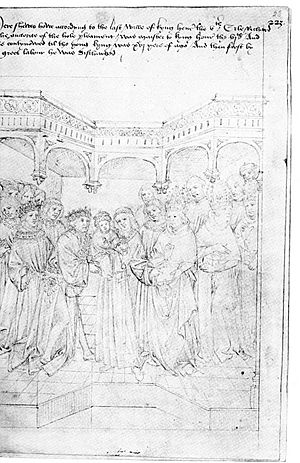
Henry was born on 6 December 1421 at Windsor Castle. He was the only child of King Henry V. He became King of England on 1 September 1422. This was the day after his father died. He was only nine months old, making him the youngest person ever to become English king.
On 21 October 1422, he also became the official King of France. This happened after his grandfather, Charles VI, died. This was part of the Treaty of Troyes from 1420. Henry's mother, Catherine of Valois, was 20 years old. English nobles did not trust her much because she was Charles VI's daughter. She was not allowed to be fully involved in raising her son.
On 28 September 1423, nobles promised their loyalty to Henry VI. He was not yet two years old. They called a Parliament in his name. They set up a regency council to rule until the King was old enough.
One of Henry V's brothers, John, Duke of Bedford, was the main regent. He was in charge of the war in France. When Bedford was away, Henry V's other brother, Humphrey, Duke of Gloucester, led the government in England. He was called Lord Protector. His job was to keep peace and call Parliament. Henry V's uncle, Henry Beaufort, also had an important role. After the Duke of Bedford died in 1435, the Duke of Gloucester wanted to be the only regent. But other council members disagreed.
From 1428, Henry's teacher was Richard de Beauchamp, Earl of Warwick. Henry was also taught by a doctor named John Somerset from 1430 to 1432. Somerset's job was to teach the young king and keep him healthy. Somerset stayed with the royal family until 1451. The English House of Commons asked for him to be removed. They said he had a "dangerous influence" over Henry VI.
Henry's mother, Catherine, married Owen Tudor. They had two sons, Edmund and Jasper. Henry later gave his half-brothers important titles. Edmund Tudor became the father of King Henry VII of England.
To respond to Charles VII of France being crowned in Reims Cathedral in 1429, Henry was crowned King of England. This happened at Westminster Abbey on 6 November 1429, when he was 7. Then, he was crowned King of France at Notre-Dame de Paris on 16 December 1431, at age 10. He was the only English king to be crowned in both countries.
Henry gained some independent power around his 16th birthday in 1437. This was confirmed on 13 November 1437. He started showing interest in ruling in 1434. He finally took full control of the kingdom at the end of 1437. This was during a time of money problems in England.
Henry's Rule and French Policy
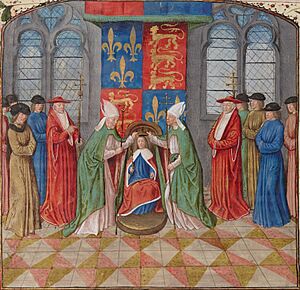
Henry was naturally shy, religious, and disliked violence. When he started ruling in 1437, a few favourite nobles controlled his court. These nobles disagreed about the war in France. After King Henry V died, England lost its strong position in the Hundred Years' War. Meanwhile, the French royal family gained power, especially after Joan of Arc's victories in 1429.
The young King wanted peace in France. He supported Cardinal Beaufort and William de la Pole, Earl of Suffolk, who also wanted peace. The Duke of Gloucester and Richard, Duke of York, who wanted to continue the war, were ignored.
Henry's Marriage
As England's military situation in France worsened, people in England talked about arranging a marriage for the king. This was to strengthen England's foreign ties and help make peace. In 1434, a marriage to a Scottish princess was suggested, but it didn't happen. In 1435, the English suggested Henry marry a daughter of King Charles VII of France. But the French refused unless Henry gave up his claim to the French throne. Another idea in 1438 to marry a German princess also failed.
Better chances for England appeared when French lords resisted the growing power of the French monarchy. This led to the Praguerie revolt in 1440. In 1441, Charles, Duke of Orléans, suggested Henry VI marry a daughter of John IV, Count of Armagnac. Armagnac was a powerful noble in southwestern France who disagreed with the French king. An alliance with Armagnac would have helped protect English Gascony. This idea was considered seriously until 1443. But a French military campaign in 1442 scared the Count of Armagnac. The deal fell apart.
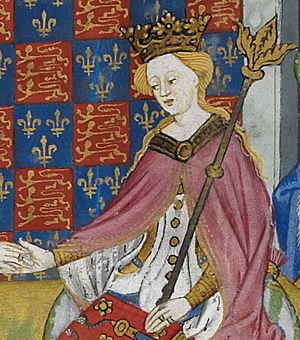
Cardinal Beaufort and the Earl of Suffolk convinced Henry that marrying Margaret of Anjou was the best way to get peace with France. Margaret was the niece of King Charles VII. Henry agreed, especially after hearing about Margaret's beauty. He sent Suffolk to talk with Charles. Charles agreed to the marriage. But he said he would not give a traditional dowry. Instead, England had to give France the province of Maine.
These terms were agreed in the Treaty of Tours in 1444. But giving up Maine was kept secret from Parliament. People knew it would be very unpopular in England. The marriage happened at Titchfield Abbey on 23 April 1445. Margaret had just turned 15. She brought her own staff, which increased the royal household's size. This meant more costs but also more chances for people to gain favour at court.
Henry hesitated to give Maine to Charles. He knew it was unpopular and would be opposed by the Dukes of Gloucester and York. Maine was also important for defending Normandy. However, Margaret was determined that he should go through with it. When the treaty became public in 1446, people blamed the Earl of Suffolk. But Henry and Margaret protected him.
Suffolk and Somerset Gain Power
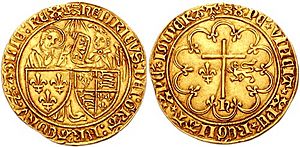
In 1447, the king and queen called the Duke of Gloucester to Parliament. He was accused of treason. Queen Margaret did not tolerate any disloyalty. This action was pushed by Gloucester's enemies: the Earl of Suffolk, whom Margaret highly respected, and the aging Cardinal Beaufort and his nephew, Edmund Beaufort, Earl of Somerset. Gloucester was arrested in Bury St Edmunds. He died there, likely from a heart attack, before his trial.
The Duke of York was the most powerful duke. He was also related to Edward III and had a strong claim to the throne after Gloucester. But he was kept away from the court. He was sent to govern Ireland. Meanwhile, his opponents, the Earls of Suffolk and Somerset, were given higher titles as dukes. The new Duke of Somerset was sent to France to lead the English army. This important job used to belong to the Duke of York. York was upset that his term was not renewed and that his enemy took over.
In Henry's later years, the monarchy became very unpopular. This was because of a lack of law and order, corruption, and the king giving royal land to his favourite people. The crown's money problems and the loss of land in France also made people unhappy. In 1447, people in the Commons (Parliament) campaigned against William de la Pole, 1st Duke of Suffolk. He was the most disliked person around the king and was seen as a traitor. Parliament accused him, and London crowds demanded his punishment. Henry had to send him away. But Suffolk's ship was stopped in the English Channel. His body was found on the beach at Dover.
Henry's mental health started to get worse in the late 1440s. He showed signs of paranoia and grand ideas. By 1449, many people questioned his ability to rule because of his mental state.
In 1449, the Duke of Somerset, leading the army in France, started fighting again in Normandy. But by autumn, the French had pushed him back to Caen. By 1450, France had taken back all of Normandy. English soldiers returning home often had not been paid. This added to the lawlessness in southern England. Jack Cade led a rebellion in Kent in 1450. He called himself "John Mortimer," showing support for York. Henry came to London with an army to stop the rebellion. But Cade had fled. Cade then ambushed a small force at the Battle of Solefields. He returned to take over London. The rebellion did not achieve much. London was taken back after a few days, mainly by its own residents. But the rebellion showed how much discontent there was.
In 1451, the Duchy of Aquitaine, which England had held since Henry II's time, was also lost. In October 1452, an English army took back Bordeaux in Aquitaine. But by 1453, Bordeaux was lost again. This left Calais as England's only territory on the European continent.
Henry's Illness and York's Rise
In 1452, the Duke of York was convinced to return from Ireland. He wanted to take his rightful place on the council and end the bad government. Many people supported him. He quickly gathered an army at Shrewsbury. The king's court gathered their own army in London. They faced each other south of London. The Duke of York presented a list of complaints and demands. He wanted Edmund Beaufort, Duke of Somerset, arrested. The king first agreed, but Margaret stopped Beaufort's arrest. By 1453, Somerset had regained his influence, and York was alone again. The court was also strengthened by the news that the queen was pregnant.
However, in August 1453, Henry received bad news. His army had been defeated in the important Battle of Castillon. Soon after, Henry had a mental breakdown. He became completely unresponsive for over a year. At 31, he "fell by a sudden and accidental fright into such a weak state of health that for a whole year and a half he had neither sense nor reason capable of carrying on the government." He did not even react to the birth of his son, Edward, six months into his illness.
Henry might have inherited a mental health condition from his grandfather, Charles VI of France. Charles VI had periods of mental illness for 30 years. Some studies suggest this illness was schizophrenia. During his sickness, Henry VI was cared for by surgeons.
Meanwhile, the Duke of York gained a powerful ally: Richard Neville, 16th Earl of Warwick. Warwick was one of the most influential nobles, possibly richer than York himself. York was named regent, or Protector of The Realm, in 1454. The queen was completely excluded. Edmund Beaufort was held in the Tower of London. Many of York's supporters spread rumours that Edward was not the king's son, but Beaufort's. During his time as regent, York worked on solving the problem of government overspending.
The Wars of the Roses Begin
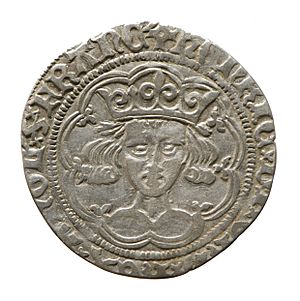
Around Christmas Day 1454, King Henry regained his senses. Unhappy nobles who had grown powerful during Henry's reign took action. The most important were the Earls of Warwick and Salisbury. They supported the rival House of York. First, they wanted control of the government. Then, from 1460, they wanted the throne itself. They pointed out that York had a better claim to the throne through Edward III. It was agreed that York would become Henry's successor, even though York was older. In 1457, Henry created the Council of Wales and the Marches for his son, Prince Edward. In 1458, he tried to unite the fighting groups by holding The Love Day in London.
Despite these attempts at peace, tensions between the houses of Lancaster and York led to open war. Their armies fought at the Battle of Northampton on 10 July 1460. The king was captured and held by the Yorkists. Queen Margaret, who was also at the battle, escaped with her son. She fled through Wales to Scotland. There, she found safety with the queen regent, Mary of Guelders. She worked to get support for her husband from Scotland.
At the end of the year, the English queen returned to England with an army. She fought the Duke of York at the Battle of Wakefield on 30 December 1460, where York died. A few weeks later, at the Second Battle of St Albans on 17 February 1461, her forces fought the Earl of Warwick. Warwick was holding her husband captive. She defeated Warwick and freed the king. Henry's mental state at the time was so poor that he reportedly laughed and sang as the battle raged around him.
However, the victory did not last long. Within six weeks, the king and queen's forces were defeated again. This happened at the Battle of Towton on 29 March 1461, by the Duke of York's son, Edward. Henry and Margaret avoided capture by Edward. This time, they both escaped to Scotland. With Scottish help, Margaret traveled to Europe to get more support for her husband.
Margaret led the Lancastrian resistance in northern England during Edward IV's first reign. But they had little success in battle. At the same time, an English embassy to Scotland, led by the Earl of Warwick for Edward, further weakened Henry's position at the Scottish Court. After the queen mother died in November 1463, Scotland sought peace with England. The exiled king returned across the border to seek help from loyal nobles in northern England and Wales.
After being defeated in the Battle of Hexham on 15 May 1464, Henry became a fugitive in his own land. He found safety in various Lancastrian homes in northern England. While hiding at Waddington Hall, he was betrayed. On 13 July 1464, Yorkist men entered the house to arrest him. Henry fled into nearby woods. But he was soon captured at Brungerley Hippings over the River Ribble. He was then held captive in the Tower of London.
Henry Returns to the Throne
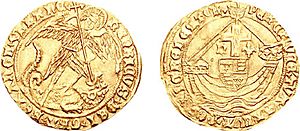
Queen Margaret, who was in exile in Scotland and France, was determined to win back the throne for her husband and son. She could do little by herself. However, Edward IV eventually had a falling out with two of his main supporters. These were Richard Neville, Earl of Warwick, and Edward's younger brother, George, Duke of Clarence. King Louis XI of France encouraged them to form a secret alliance with Margaret.
After Warwick married his daughter Anne to Henry and Margaret's son, he returned to England. He forced Edward IV into exile. Henry VI was put back on the throne on 3 October 1470. This event is sometimes called the "readeption". However, by this time, years of hiding and captivity had taken a toll on Henry. Warwick and Clarence effectively ruled in his name.
Henry's return to the throne lasted less than six months. Warwick soon went too far by declaring war on Burgundy. Its ruler, Charles the Bold, helped Edward IV regain his throne by force. Edward returned to England in early 1471 and made peace with Clarence. Warwick was killed at the Battle of Barnet on 14 April. The Yorkists won a final victory at the Battle of Tewkesbury on 4 May. Henry's son, Edward of Westminster, was killed there.
Imprisonment and Death
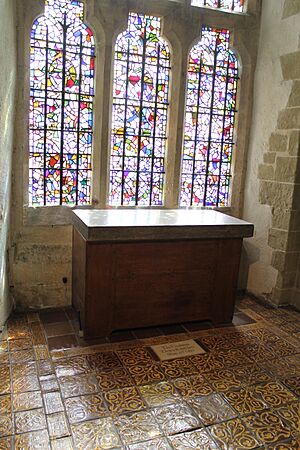
Henry was imprisoned in the Tower of London again. When the royal group arrived in London, he was reported dead. Official records say the deposed king died on the night of 21 May 1471. It is likely his enemies kept him alive until then. This was to avoid having Henry's son, Edward, as a more powerful Lancastrian leader. However, once the main Lancastrian supporters were killed or exiled, Henry VI became a burden to Edward IV's reign. People feared another noble might use the mentally unwell king for their own goals.
According to an official record that favoured Edward IV, Henry died of sadness. But it is widely believed that Edward IV, who was crowned again the morning after Henry's death, ordered his murder.
Sir Thomas More's History of Richard III clearly states that Richard, then the Duke of Gloucester, killed Henry. Another source from that time says Henry died on 23 May 1471. On that date, Richard, who was only eighteen, was known to be away from London.
Today, people often say he died in Wakefield Tower in the Tower of London. But there is no evidence to support this. It is unlikely, as the tower was used for storing records at that time. Henry's actual place of death is unknown, though he was imprisoned within the Tower of London.
King Henry VI was first buried in Chertsey Abbey in Surrey. But in 1484, Richard III had his body moved to St George's Chapel, Windsor Castle. When his body was examined in 1910, it was found to be 175 cm (5 ft 9 in) tall. Light hair was found covered in blood, and his skull was damaged. This strongly suggests the king died by violence.
Henry's Legacy
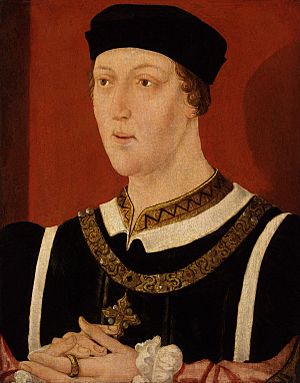
Education and Buildings
Henry's most lasting achievement was his support for education. He founded Eton College, King's College, Cambridge, and All Souls College, Oxford. He continued his father's work in building. King's College Chapel and Eton College Chapel are examples. Most of his building projects were churches in the late Gothic or Perpendicular style. They often had a monastery or school attached.
Every year on the day Henry VI died, the leaders of Eton and King's College place white lilies and roses on the spot in Wakefield Tower. This is where tradition says Henry VI was murdered while praying. There is a similar ceremony at his burial place, St George's Chapel.
Henry as a Saint
People believed Henry could perform miracles. He was informally seen as a saint and a martyr. People prayed to him, especially when they faced difficulties. Henry VII of England encouraged this belief to strengthen his family's claim to the throne. A book was made listing the miracles attributed to Henry at St George's Chapel, Windsor. Henry VII began building a chapel at Westminster Abbey for Henry VI's remains.
Some of Henry VI's miracles had a political meaning. For example, he cured a young girl with the King's evil. Her parents refused to take her to the new king, Richard III. By the time Henry VIII broke away from Rome, the process to make Henry a saint was underway. Hymns written for him still exist. Until the Reformation, his hat was kept at his tomb in Windsor. Pilgrims would wear it to ask for Henry's help with headaches.
Many miracles were credited to the dead king. These included bringing a plague victim back to life. He also helped a man who was wrongly sentenced to death for stealing sheep. Henry put his hand between the rope and the man's throat, keeping him alive. The man then woke up in the cart taking him to be buried. Henry could also cause harm. For example, he made John Robyns blind after Robyns cursed "Saint Henry." Robyns was cured only after he went on a pilgrimage to King Henry's shrine. A special act of devotion to Henry VI was bending a silver coin as an offering. This was done so he might perform a miracle. One story tells of a woman, Katherine Bailey, who was blind in one eye. A stranger told her to bend a coin to King Henry. She promised to do so, and her sight was cured during mass.
Henry VI's shrine was very popular for pilgrimages in the early 1500s. But over time, as the Tudor family's rule became more secure, his cult faded.
Images for kids
See also
 In Spanish: Enrique VI de Inglaterra para niños
In Spanish: Enrique VI de Inglaterra para niños


